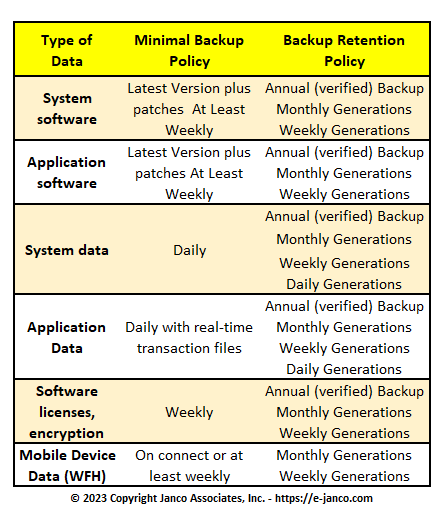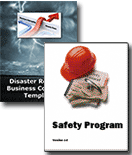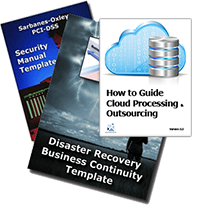Disaster Cleanup -- Best Practices on How To Cleanup
Disaster Recovery Plan Template Business Continuity
ISO 27000 (formerly ISO 17799), Sarbanes - Oxley, GDPR, CCPA, COBIT PCI-DSS & HIPAA Compliant
Order DRP BCP Template Sample DRP BCP Template
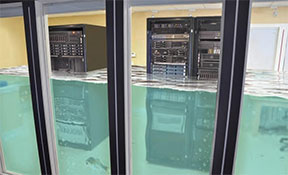
You have had a disaster and now you are starting to look at the "mess" that you have. What do you do to clean things up? Some tips on disaster recovery and business continuity clean up are:
-
Wet objects (electronic) - Disconnect from the power source and do not turn it on. In the case of disk drives or other electronic storage devices - inventory all of them and label them. Create a log of all objects recovered, actions taken, and location. Have a disaster clean-up specialist be the one who looks at what can be recovered.
-
Wet objects (non-electronic) - Rinse with clear water or a fine hose spray. Clean off dry silt and debris with soft brushes or dab with damp cloths. Try not to grind debris into objects; overly energetic cleaning will cause scratching. Dry with a clean, soft cloth. Use plastic or rubber gloves for your own protection.
Drying Objects - Air dry objects indoors if possible and use portable fans to move the air. Sunlight and heat may dry certain materials too quickly, causing splits, warping, and buckling. If possible, remove contents from wet objects and furniture prior to drying. Storing damp items in sealed plastic bags will cause mold to develop. If objects are to be transported in plastic bags, keep bags open and air circulating.
-
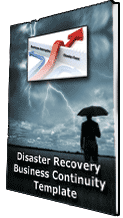 Mold Prevention and Cleanup - Exposure to molds can have serious health consequences such as respiratory problems, skin and eye irritation, and infections. The use of protective gear, including a respirator with a particulate filter, disposable plastic gloves, goggles or protective eye wear, and coveralls or a lab coat, is therefore essential. In order to inhibit the growth of mold and mildew you must reduce humidity. Increase air flow with fans, open windows, air conditioners, and dehumidifiers. Moderate light exposure (open shades, leave lights on in enclosed areas) can also reduce mold and mildew. Remove heavy deposits of mold growth from walls, baseboards, floors, and other household surfaces with commercially available disinfectants. Avoid the use of disinfectants on historic wallpapers. Follow manufacturers' instructions, but avoid splattering or contact with objects and wallpapers as disinfectants may damage objects.
Mold Prevention and Cleanup - Exposure to molds can have serious health consequences such as respiratory problems, skin and eye irritation, and infections. The use of protective gear, including a respirator with a particulate filter, disposable plastic gloves, goggles or protective eye wear, and coveralls or a lab coat, is therefore essential. In order to inhibit the growth of mold and mildew you must reduce humidity. Increase air flow with fans, open windows, air conditioners, and dehumidifiers. Moderate light exposure (open shades, leave lights on in enclosed areas) can also reduce mold and mildew. Remove heavy deposits of mold growth from walls, baseboards, floors, and other household surfaces with commercially available disinfectants. Avoid the use of disinfectants on historic wallpapers. Follow manufacturers' instructions, but avoid splattering or contact with objects and wallpapers as disinfectants may damage objects. Broken Objects - If objects are broken or begin to fall apart, place all broken pieces and detached parts in clearly labeled, open containers. Do not attempt to repair objects until completely dry or, in the case of important materials, until you have consulted with a professional conservator.
Paper Materials - Documents, books, photographs, and works of art on paper are extremely fragile when wet; use caution when handling. Free the edges of prints and paper objects in mats and frames, if possible. These should be allowed to air dry. Rinse mud off wet photographs with clear water, but do not touch surfaces. Wet books and papers should also be air dried or kept in a refrigerator or freezer until they can be treated by a professional conservator.
Office Furniture - Furniture finishes and painting surfaces may develop a white haze or bloom from contact with water and humidity. These problems do not require immediate attention; consult a professional conservator for treatment. Textiles, leather, and other "organic materials will also be severely affected by exposure to water and should be allowed to air dry. Shaped objects, such as garments or baskets, should be supported by gently padding with toweling or un-inked, uncoated paper. Renew padding when it becomes saturated with water. Dry clean or launder textiles and carpets as you normally would.
Art Work - Remove wet paintings from the frame, but not the stretcher. Air dry, face up, and away from direct sunlight.
Metal Objects - Rinse metal objects exposed to flood waters, mud, or silt with clear water and dry immediately with a clean, soft cloth. Allow heavy mud deposits on large metal objects, such as sculpture, to dry. Caked mud can be removed later. Consult a professional conservator for further treatment.
Order Disaster Plan Template Download DRP Customer Base
The DRP template is over 200 pages and includes everything needed to customize the Disaster Recovery Plan to fit your specific requirement. The electronic document includes proven written text and examples for the following major sections of a disaster recovery plan:
- Plan Introduction
- Business Impact Analysis - including a sample impact matrix
- DRP Organization Responsibilities pre and post disaster - DRP checklist
- Backup Strategy for Data Centers, Departmental File Servers, Wireless Network servers, Data at Outsourced Sites, Desktops (In office and "at home"), Laptops and PDA's
- Recovery Strategy including approach, escalation plan process and decision points
- Disaster Recovery Procedures in a check list format
- Plan Administration Process
- Technical Appendix including definition of necessary phone numbers and contact points
- Job Description for Disaster Recovery Manager (3 pages long) - entire disaster recovery team job descriptions are available
- Work Plan to modify and implement the template. Included is a list of deliverables for each task. (Risk Assessment and Vulnerability Assessment)
There is a extensive section that show how a full test of the DRP can be conducted. It includes
- Disaster Recovery Manager Responsibilities
- Distribution of the Disaster Recovery Plan
- Maintenance of the Business Impact Analysis
- Training of the Disaster Recovery Team
- Testing of the Disaster Recovery Plan
- Evaluation of the Disaster Recovery Plan Tests
- Maintenance of the Disaster Recovery Plan
- Electronic forms
- Key Job Description
Click on the link below to get the DRP/BC sample pages now and make it part of your disaster recovery toolkit.
Backup Matrix - Sample from Template
Order Disaster Plan Template Download DRP Customer Base

